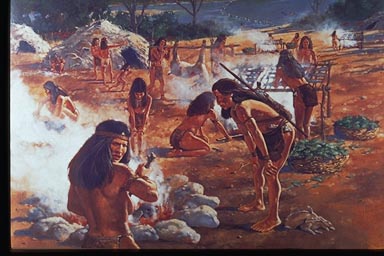The Georgia Archaeology Home Page
Georgia: The Archaic Period
(ca. 8,000-1,000 B.C.)
Home Page
By approximately 8,000 B.C. the area that is now the state of Georgia was occupied by groups of people organized in a way that allowed them to take full advantage of the abundant resources available to them in an environment that was steadily becoming like the one that Europeans first encountered, and is still observable in a few places today.
Small groups of people, perhaps 25-50 individuals from 3 or 4 extended families, lived together for most of the year. They established camps in areas that they could exploit for plant and animal (mammals, fish, reptiles, etc.) resources that were ripening and/or becoming abundant during specific times of the year. Once the resources were depleted, they moved on to other areas that provided logistical economic and political advantages with regard to available resources.
In the Southeast, habitation structures primarily consisted of small houses that were constructed by placing cut posts vertically into the ground at regular intervals, and weaving smaller saplings and other vegetation between them. Sometimes, wet clay was applied to the exterior and allowed to dry. This type of architecture is referred to as "wattle and daub."
